 |

| |
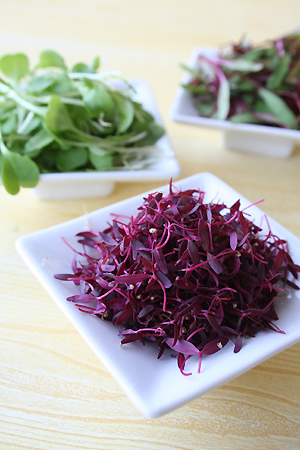
A trio of microgreens, with Red Amaranth in front. Eating them as salad is a pleasure for those with deep pockets, but buying a few boxes for a dinner party will give you the most beautiful, delicious and easy garnishes for almost anything you serve. Photography by Claire Freierman. |
| WHAT IT IS: Tiny vegetables, no more than two weeks old. |
| WHY IT’S DIFFERENT: Most of us don’t get to see microgreens unless we dine at expensive restaurants, where chefs use them to garnish dishes. THE NIBBLE has sourced a leading grower who will ship them directly to our readers. |
| WHY WE LOVE IT: Gorgeous, high flavor, and just incidentally, high nutrition and low calorie. They make anything we serve look terrific. |
| WHERE TO BUY IT: Telephone Mr. McGregor’s Specialty Greens at 1.856.451.8800, weekdays from 8 a.m. to 4 p.m., Eastern Time. |
|
|
 |

Mr. McGregor’s Microgreens:
Micro Calories, Macro Excitement
It is only January, yet we know that Mr. McGregor’s microgreens are going to be among the top 10 most exciting foods we’ll try this year. And, we’ll sample 3,000 to 5,000 specialty food products!
What are microgreens? They are tiny, tiny vegetables, no more than 8 to 14 days old, that have just developed their cotyledon (first) leaves. They are far tinier than “baby greens.” Think of the first, threadlike shoot that rises when you plant a seed, and the first tiny leaves, barely a quarter-inch in diameter. You may have seen a few scattered on your plate or garnishing your food at fine restaurants.
Microgreens are very tender and oh, what flavor! Both intense and delicate, visually captivating and sublime to eat, they are a gourmet experience. Yet, they are highly nutritious with scarcely a calorie. For people who already like greens, microgreens are the zenith. For people who do not care for salad or raw vegetables: If you don’t like these precious greens, we’ll rest our case. Use them in salads, main dishes, soups and as general garnishes. Read the full review below, and see more photos of these minute, exquisite vegetables.
|
| |
|
|
THE NIBBLE does not sell the foods we review
or receive fees from manufacturers for recommending them.
Our recommendations are based purely on our opinion, after tasting thousands of products each year, that they represent the best in their respective categories. |
Enjoy More Exciting Salads
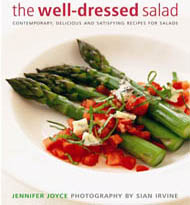 |
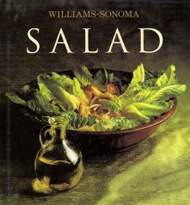 |
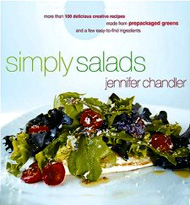 |
The Well-Dressed Salad, by Jennifer Joyce. If you view salads beyond a few greens on the side, this book will expand your horizons even more. With stylish, healthy recipes that explore textures and flavors from around the world, you’ll make exciting vegetable, noodle, rice, meat, fish and poultry salads that promise to please as both sides and mains for lunch and dinner. Click here for more information or to purchase. |
The Williams-Sonoma Collection: Salad, by Georgeanne Brennan. Brennan wisely addresses salad recipes by season, pointing out when ingredients are at their best and most affordable. There are chapters on the great classic salads, as well as picnic salads that can be assembled on the spot. Basics on dressings and vegetables are also covered. Click here for more information or to purchase. |
Simply Salads: More than 100 Delicious Creative Recipes Made from Prepackaged Greens and a Few Easy-to-Find Ingredients, by Jennifer Chandler. Creative recipes include Margarita Chicken Salad, Steakhouse Salad with blue cheese and bacon and Lobster Salad with grapefruit vinaigrette, with numerous worthy dressings and slaws. Click here for more information or to purchase. |
Mr. McGregor’s Microgreens: Micro Calories, Macro Excitement
INDEX OF REVIEW
|
MORE TO DISCOVER
|
Microgreens aren’t baby greens—they’re more like newborn greens, just 8 to 14 days old. Tender and delicate, they taste, not surprisingly, like a wee version of what they will be when they grow up. The salad greens called “baby greens” are several weeks older, with leaves two or so inches long—a legitimate forkful of greens. They are familiar to many people as the baby lettuces in a mesclun mix.* Several more weeks in the ground, and the sweet baby lettuces grow up to be big heads of red leaf lettuce and escarole, tall bunches of arugula and basil. To get them fork-ready, you have to tear them into bits the size of what they were when they were baby greens.
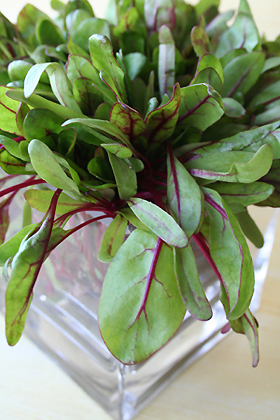
Please eat the centerpiece: It’s made of baby greens—here, Beet Tops. You’ll see the microgreen Beet Tops in a photo below. |
*Mesclun is Provençal patois, and specifically refers to a mixture of young lettuces. In France the word is pronounced mess-CLOON. In America it is acceptable to say mess-CLUHN, but never mess-kuh-LEEN, which those who are old enough, know as a psychedelic drug unrelated to salad. However, food trivia buffs, the same agave cactus that yielded the original mescaline (a.k.a. peyote) also provides the agave juice which distills into mezcal, a tequila-like spirit that is undergoing a renaissance.
Microgreens are not sprouted seeds, although some of the same seeds that are sprouted (a process that involves soaking in water until the seed sprouts) are grown as microgreens—broccoli, mustard, peas and radishes, for example.
More than a few people, while appreciating the nutrition of sprouts, would describe them as vegetal or earthy in character—not a luscious treat. Microgreens, on the other hand, are an ethereal pleasure. Like sprouts, they are very nutritious: Studies have shown that the smaller plant (i.e., the microgreens) contains a higher percentage of beneficial compounds than the mature plant. And, they are very low in calories. Jackpot!
|
Each grower has his or her own roster of microgreens. You’ll find some varieties at Mr. McGregor’s that you won’t find elsewhere, and vice versa, some grown at the request of local restaurateurs and retailers. Mr. McGregor’s currently offers:
-
28 individual types of microgreens, some of which we’ve reviewed below, and all of which are listed in the Shopping Information area
- 10 microgreen mixes, including Asian, Basil, Broccoli, Herb, Radish, Rainbow (a bit of everything), Spring, Summer, Sweetheart and Vegetable
- 20 types of baby greens with roots attached—so pretty you can use them as a centerpiece (see photo above); from familiar names (Arugula, Mâche, Red Mustard Greens) to the less so (Firecracker, Lolla Rosa, Red Orach)
We first tasted Mr. McGregor’s, whose greenhouses are in southern New Jersey, this past fall when the full line was on exhibit at a show for restaurateurs—and we were in heaven. We could not believe what it was like to have mouthfuls of Beet Tops, Red Cabbage, Red Mustard and others of these treasures—as opposed to the pinches usually meted out by restaurant chefs.
We had a more limited tasting last week in THE NIBBLE offices, where the microgreens were proclaimed an incredible find. The truly incredible part is that Mr. McGregor’s will sell them directly to NIBBLE readers—the company typically sells just to professionals. Perhaps it is our powers of persuasion.
The greens are grown hydroponically in the greenhouses. Hydroponics is a method of growing plants using mineral nutrient solutions instead of soil. While soil holds nutrients that plants absorb through their roots, it is not essential to plant growth (think of water lilies).
Almost any plant can be grown hydroponically, although some are better suited to the technique. While hydroponics enables food and other plants to be grown where land is not arable, it is not a cost-effective production technique. (If you think soil-grown tomatoes are pricey, hydroponic tomatoes start to look like luxury food.) On the other hand, greenhouse hydroponics is the perfect way to grow delicate microgreens. |
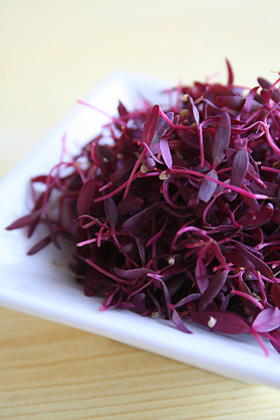
Red Amaranth microgreens: A beet-red herb with a
slight flavor of beets. |
Microgreen Varieties
We’ll focus on the individual microgreens in this review. The baby greens, older and more developed, taste different and have largely salad applications (although they’ll make the best salad you’ve ever had). It’s best to discuss your preferences with the folks at Mr. McGregor’s and get their recommendations. Microgreens are more versatile, so to introduce you to the category, we’ll focus on them.
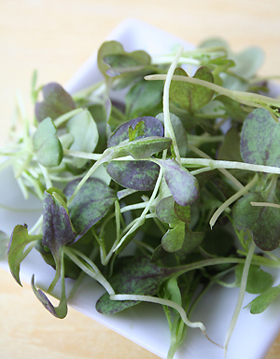
Micro Red Mustard. The leaves are heart-shaped and
tinged dark red. |
Any vegetable can be harvested in its microgreen stage. When we first tasted Mr. McGregor’s greens, something very green tasted like sweet, fresh corn. Yes, it was two-week-old corn shoots, barely two inches high. Left to grow over a season, they’d be stalks taller than we; but tasting them, tiny and tender at the end of our fork, we could only smile and think that the child is father to the man—even if the man is corn-on-the-cob.
The current microgreen lineup includes Arugula, Basil (plus regular, Lemon, Opal and Thai Basils), Beet Tops (Red Beet, Bull’s Blood and Yellow Beet), Broccoli, Celery, Chard (Rainbow and Ruby Red), Chrysanthemum, Cilantro, Collard Greens, Corn Shoots, Curly Cress, Green Oak Lettuce, Kale, Mint, Mizuna, Mustard (Green and Red), Onion Sprouts, Pea Tendrils, Peppercress, Purple Kohlrabi, Radish (China Rose, Daikon and Purple), Red Amaranth, Red Cabbage, Red Russian Kale and Tatsoi. |
When we tasted everything this past fall, we had no complaints—in fact, we were in heaven. Here are the notes from this week’s tasting in THE NIBBLE offices, with a more limited selection.
Micro Arugula. Micro arugula looks like tiny two-leaf clovers (as do many of the cotyledons, the tiny first leaves). But it tastes just like baby arugula—the kind you may be able to purchase from your greengrocer. This is one of the best-sellers and we loved it, but given the wealth of riches at Mr. McGregor’s and our access to baby arugula at our local market, we’d spend our micro-dollars on tastes that are more hard to come by.
Micro Beet Tops (photo at right). How lovely these are: graceful, red stems and oblong green leaves. They’re an ideal Christmas garnish, but they’re perfect every day of the year. The beet flavor is as subtle as a whisper. Mr. McGregor also grows Baby Beet Tops—salad greens—that have divine beet flavor.
Micro Bull’s Blood. There’s a Hungarian wine of the same name, but this Bull’s Blood is a variety of beet grown for its striking reddish-purple leaves, which add drama to salad mixes. It looks just like the Micro Beet Tops but the leaves are reddish-purple instead of green. We prefer the red-and-green contrast of the regular Beet Tops, as well as their flavor. If you’re looking for something all red (or actually, all purplish-red), consider the Red Amaranth as well.
|
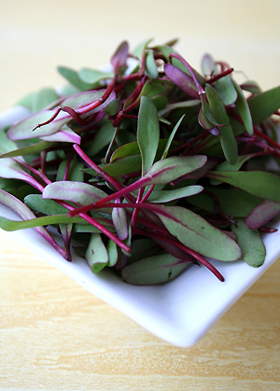
Micro Beet Tops are among the more dramatic lookers, along with Micro Bull’s Blood and Red Amaranth. The ethereal flavor of beets will enchant any beet lover. |

See the tiny, serrated leaves. Look familiar? It’s Micro Celery. |
Micro Celery. Celery is so vestigial in food circles these days, if it isn’t needed for a mirepoix† or to give crunch to a tuna salad, it seems to have no significant place. But Micro Celery makes us want to take another look at those Pascal celery stalks. The microgreens have much more celery flavor than bland supermarket celery. Since we can’t afford a steady supply of these microgreens and their wonderful fresh flavors, we’re going to take a new look at using the leaves of ordinary celery for garnish (perhaps the leaves mixed with a tiny dice of stalk).
†The combination of onions, carrots and celery used to start many classic French sauces, soups, stocks and stews.
Micro Mizuna. Mizuna belongs in the family that includes bok choy, broccoli rabe, Chinese cabbage and turnips. It grows quickly so growers like it, and has become popular with chefs who are looking to show their customers something new. In its microgreen form, it tastes similar to tatsoi, but milder; you don’t want to order both (we’d go for the tatsoi). Mr. McGregor also grows baby mizuna as a salad green, which is a beautiful and distinctive-looking leaf for a mesclun mix.
|
Micro Peppercress. The most complex of microgreen flavors came from Micro Peppercress. Peppery? Indeed! But it’s also sweet, lemony—there’s a whole of flavor going on. This skinny fellow needs to be in a mix, because, as was so pointedly stated in “A Chorus Line,” Dance 10, Looks 3.
Micro Red Amaranth (photo at top of page). Perhaps the most striking in the looks department, just gazing at this microgreen begs the question, “What is it?” and then the next question, “What’s amaranth?” There are about 60 species of the herb amaranth, also known as pigweed. Why such a glorious plant, whose leaves range from gold to purple to red, is called “pigweed,” we’re not going to take time to research. Let’s assume that the pigs found its beet-like flavor as tasty as we do.
Micro Red Cabbage (photo at right). The cabbage microgreens are the loveliest looking, in our opinion, sporting not only red shading in the leaf, but a pale red stem. They are similar in visual style to the heart-shaped mustard (see next description), but the ones we got were larger-leafed, and the violet-red stems are just exquisite. If you included a generous forkful on the plate, perhaps next to a pale piece of fish or chicken, few would guess it to be cabbage, although all would (we hope) deem it delightful. It could have grown up to be a big, round head of red cabbage; today it is our tender treat.
|
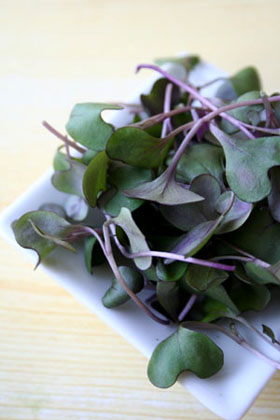
Red Cabbage microgreens: Awarded the trophy for Best Looking. |
Micro Red Mustard (photo above). Love mustard? Try it in this form—it’s wonderful. Your salad green is already naturally flavored with Dijon, as it were; there’s no need to add mustard to the vinaigrette. The flavor is wonderful in mixes, too. Micro Red Mustard and Micro Red Cabbage are perfect garnishes for a romantic dinner. The leaves are heart-shaped and tinged dark red; unlike the Red Cabbage, though, Micro Red Mustard stems are green and the leaves are a lighter, brighter green.
Micro Red Russian Kale. We love lightly-cooked red kale, and have had it in a mesclun mix, but had never considered mature as a salad green. Having had the microgreens and the baby greens, kale salad now seems as natural as spinach salad. The microgreens have a subtle flavor that identifies them as a member of the cabbage family, but in the sweetest possible way. (Broccoli, Brussels sprouts, cauliflower, collard greens and kale belong to the same cultivar group.)
Micro Tatsoi. We were introduced to tatsoi by an organic farmer who sells it (and mizuna, among other baby greens) at our local farmers market. Also called spinach mustard, spoon mustard and rosette bok choy, it does taste like bok choy lightly crossed with mustard. In microgreen form, it’s all green, a tiny “two-leaf-clover.”
Pea Tendrils. Pea plants are climbers. If you’ve seen them growing, you know that the leaves shoot out thin tendrils whose purpose is to coil around any available support, to let the plant climb (it can grow up to six feet or so). These delicate bits of vine, tasting of the promise of fresh spring peas, come in mixed lengths of about three and four inches. A four-inch piece held more than a dozen leaves and three curly tendrils, and made a dramatic garnish. See how many of your guests recognize the vegetable from its tendrils before they take a bite and realize they are eating the progenitor of peas.
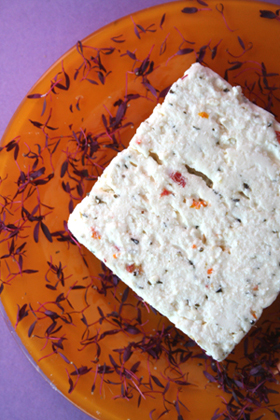
Faced with plating a piece of feta cheese that, in the pantheon of cheeses, is not the most elegant slice one could present, we created glamour with Red Amaranth microgreens. The orange plate alone wasn’t enough–it looked stark and lunar against the white cheese—and of course, the white cheese faded into a white plate. The Red Amaranth looked Belle Epoque. By the way, the pieces of bell pepper in the feta came with the cheese—it’s the Mediterranean Feta from Nikos. |
Serving Suggestions
Aside from eating a pile of microgreens as a delicious luxury vegetable, here’s how you can enjoy them:
|
Finale
Microgreens aren’t inexpensive: Eight ounces are $12 and up. But your microgreen experience will be a macro revelation. People of means on the Oprah diet (i.e., you don’t worry about what it costs, you just get whatever you need) can revel in a large shipment each week, eating salads that will make everyone else microgreen with envy. (The microgreens remain fresh for five to seven days.)
The next time you feel like splurging on an expensive bottle of wine, channel that money into the discovery of microgreens. As for Peter Rabbit, while he might have been able to sneak into Mr. McGregor’s garden in his youth, as an adult, he’s going to have to pay for his treats like everybody else.
—Karen Hochman
FORWARD THIS NIBBLE to gourmets, fine cooks and affluent dieters.
Mr. McGregor’s SPECIALTY GREENS
INDIVIDUAL MICROGREENS: Arugula, Basil (plus Lemon, Opal and Thai Basils), Beet Tops (Red Beet, Bull’s Blood and Yellow Beet), Broccoli, Celery, Chard (Rainbow and Ruby Red), Chrysanthemum, Cilantro, Collard Greens, Corn Shoots, Curly Cress, Green Oak Lettuce, Kale, Mint, Mizuna, Mustard (Green and Red), Onion Sprouts, Pea Tendrils, Peppercress, Purple Kohlrabi, Radish (China Rose, Daikon and Purple), Red Amaranth, Red Cabbage, Red Russian Kale, and Tatsoi
MICROGREEN MIXES: Asian, Basil, Broccoli, Herb, Radish, Rainbow, Spring, Summer, Sweetheart, Vegetable
BABY GREENS: Arugula, Beet Tops, Bull’s Blood, Chrysanthemum, Firecracker, Green Oak, Green Romaine, Lolla Rosa, Mâche, Mizuna, Rainbow Chard, Red Amaranth, Red Cross, Red Mustard Red Oak, Red Orach, Red Romaine, Red Russian Kale, Tatsoi, Upland Cress
- 8-Ounce Individuals or Mixes
$12.00 to $27.00
Depending On Variety & Size
Telephone To Discuss Your Needs
- 4-Ounce Clam Shells
Corn Shoots, Onion Sprouts, Pea
Tendrils, Peppercress
Telephone 1.856.451.8808
Weekdays from 8 a.m. to 4 p.m., Eastern Time
ArcGreenhouses.com
|
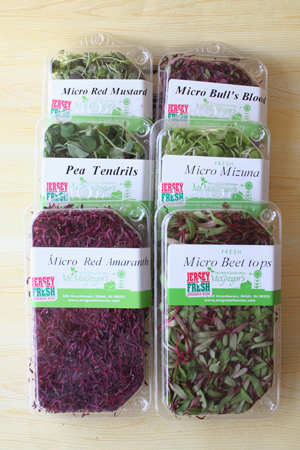
The 8-ounce boxes, shown, will amply garnish 12 or so plates for a dinner party.
|
Prices and product availability are verified at publication but are subject to change. Shipping is additional. THE NIBBLE does not sell products; these items are offered by a third party and we have no financial relationship with respect to this sale. Information to purchase is provided as a reader convenience.
Read More About Our Favorite
Vegetables & Related Products:
|
Check Out These Other “Top Pick Of The Week” Healthy Products:
|
FOR ADDITIONAL INFORMATION, special offers,
contests, opinion surveys, THE NIBBLE
prior issues archive, product gift-finder and more,
visit the home page of TheNibble.com.
Do you have friends who would enjoy THE NIBBLE?
Click here to send them an invitation to sign up for their own copy. |
© Copyright 2004-2025 Lifestyle Direct, Inc. All rights
reserved. All information contained herein is subject to change at any time
without notice. All details must be directly confirmed with manufacturers, service
establishments and other third parties. The material in this e-zine may not
be reproduced, distributed, transmitted, cached, or otherwise used, except with
the prior written permission of Lifestyle Direct, Inc.
|
 |




|
 |





















